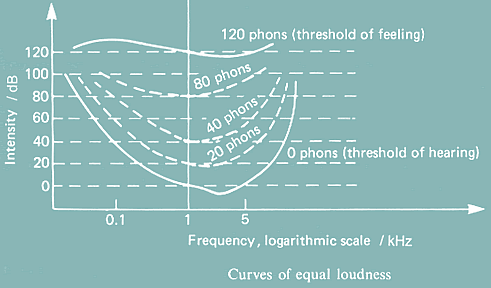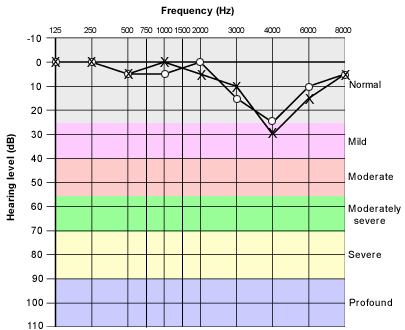    |
||||

The Ear: Loudness Perception |
||||
|
See also ear structure, attenuation and dBA/dB scales Loudness Perception
You need to know how to draw this graph! (and label axes and mark on values!) To be perceived, sounds must exert a shearing force on the stereocilia of the hair cells lining the basilar membrane of the cochlea (so that they can then send electrical signals through to the brain). Different frequencies of sound produce a different response and therefore there is a range of sound intensities necessary for the threshold of hearing over the audible hearing range. Note that the axes are BOTH logrithmic as the range is so great!
The graph below shows how loud in dB sounds have to be at various frequency to be perceived at a particular 'loudness' by us. How 'loud' the sound is depends on the amplitude of vibration of the basilliar membrane and hence the hairs that trigger electrical signal transmission in the cochlea and the number of them stimulated (Some are only stimulated above a certain threshold) The 'phon': In acoustics, a unit of subjective loudness level equal to the sound pressure level in dB compared to that of an equally loud standard sound. Note: The accepted standard is a 1-kHz pure sine-wave tone or narrowband noise centered at 1 kHz.
You need to know how to draw this graph! (and label axes and mark on values!) When excessive, this force can lead to cellular metabolic overload (compare with 'flooding' optical receptor with bright light!), and this can produce cell damage and cell death. Noise-induced hearing loss therefore represents excessive "wear and tear" on the delicate inner ear structures.
Example: A teenage girl was seen for a school physical examination. Screening audiometry performed in the office revealed a 30-dB (mild) elevation of hearing thresholds at 4,000 Hz. A confirmatory audiogram taken by an audiologist showed a sensorineural loss in a "notch" pattern at 4,000 Hz (Figure 1). In response to questioning, the girl reported spending several hours a day listening to music through headphones. The previous night, she had spent several hours at a rock concert without wearing hearing protection. Afterward, she noticed that her ears were ringing and "felt like there was cotton in them." Several days later, her hearing had returned to normal. This is an example of a person who has experienced a "temporary threshold shift." Temporary threshold shifts are common in persons exposed to excessive noise, and they represent transient hair cell dysfunction. Although apparent complete recovery from a given episode can occur, repeated episodes of such shifts occurring after noise exposures give way to permanent threshold shifts because hair cells in the cochlea are progressively lost. Summary table for
Differential Diagnosis of Sensorineural Hearing Loss |
||||
 |
||||





